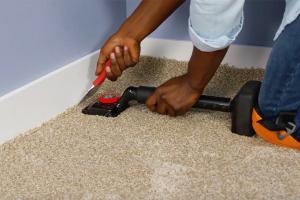Ultimate Guide to Installing Carpet: Step-by-Step Instructions for a Flawless Finish

-
Quick Links:
- Introduction
- Essential Tools and Materials
- Preparing the Space
- Step-by-Step Installation Process
- Finishing Touches
- Maintenance Tips for Carpet
- Case Studies
- Expert Insights
- FAQs
Introduction
Carpet installation can seem daunting, but with the right tools and guidance, it's a manageable DIY project that can enhance the comfort and aesthetics of your home. In this comprehensive guide, we will explore everything you need to know about how to install carpet, including the necessary tools, preparation steps, the installation process, and tips for maintenance.
Essential Tools and Materials
Before you begin, gather the following tools and materials:
- Carpet rolls or tiles
- Carpet padding
- Utility knife
- Carpet stretcher
- Seam tape
- Iron (for seams)
- Stapler or tack strips
- Measuring tape
- Chalk line
- Flooring adhesive (if needed)
Choosing the Right Carpet
When selecting carpet, consider the following factors:
- Material: Popular options include nylon, polyester, and wool.
- Pile Height: Low, medium, and high pile carpets offer different textures and comfort levels.
- Durability: Look for carpets rated for heavy foot traffic if you have pets or children.
Preparing the Space
Preparation is key to a successful carpet installation. Follow these steps:
- Clear the Room: Remove all furniture and obstacles from the area.
- Inspect the Subfloor: Ensure it is clean, dry, and smooth. Repair any damage.
- Install Carpet Padding: Lay down carpet padding to provide comfort and insulation.
Step-by-Step Installation Process
1. Measuring and Cutting the Carpet
Measure the dimensions of the room, then cut the carpet to size, leaving an extra 2-3 inches for adjustments.
2. Laying the Carpet
Start in one corner of the room and lay the carpet, making sure it aligns with the walls. Use a carpet stretcher to pull the carpet taut.
3. Securing the Carpet
Use tack strips along the edges to secure the carpet in place. Ensure the carpet is flat and smooth.
4. Trimming Excess Carpet
Carefully trim any excess carpet along the edges with a utility knife.
5. Seaming the Carpet
If you're installing multiple pieces, use seam tape and an iron to bond the edges together.
Finishing Touches
Once the carpet is laid and secured, add baseboards or trim to hide any visible edges. Vacuum the carpet to remove any debris and fluff the fibers.
Maintenance Tips for Carpet
Regular maintenance will prolong the life of your carpet:
- Vacuum at least once a week.
- Address stains immediately using appropriate cleaning solutions.
- Schedule professional cleaning every 12-18 months.
Case Studies
Case Study 1: Homeowner Jane installed carpet in her living room. By following this guide, she transformed her space within a weekend, enhancing both comfort and aesthetics.
Case Study 2: A rental property owner remodeled an apartment by installing carpet in all rooms. The low-cost installation increased rental value significantly.
Expert Insights
According to flooring expert Mike Smith, “Taking the time to properly prepare your subfloor and ensuring a tight installation can greatly affect the longevity of your carpet.”
FAQs
1. How long does it take to install carpet?
On average, it takes 4-6 hours to install carpet in a standard-sized room.
2. Can I install carpet over existing flooring?
Generally, it's best to remove old flooring for a smoother installation, but carpet can be installed over certain types if they're in good condition.
3. What type of carpet is best for high-traffic areas?
Nylon and polyester carpets are recommended for durability in high-traffic zones.
4. How do I remove carpet stains?
Blot the stain with a clean cloth and use a carpet cleaner suitable for the stain type.
5. Do I need a professional to install carpet?
While it's possible to do it yourself, hiring a professional can ensure a flawless result, especially for large spaces.
6. What is the average cost of carpet installation?
Costs can vary widely, but expect to pay between $2 to $6 per square foot for materials and installation.
7. How often should I replace my carpet?
With proper care, most carpets last 5-15 years. Signs of wear include fraying and fading.
8. Can I use carpet tiles instead of rolls?
Yes, carpet tiles are a great alternative, especially for DIY projects due to their ease of installation and versatility.
9. How do I measure a room for carpet?
Measure the length and width of the room and multiply the two numbers to get the square footage.
10. What is carpet padding, and do I need it?
Carpet padding is a layer of cushioning that provides comfort and extends the life of your carpet. It is highly recommended.